|
|
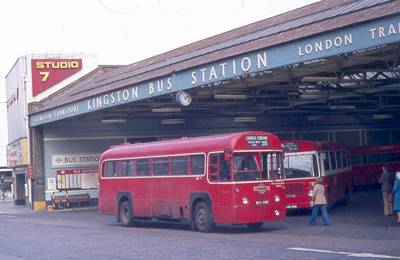 Red RF routes Red RF routes
Route 215
Page last updated 27 July 2019
Utterly fascinating (well, people who like this sort of thing
find this is the sort of thing they like). The RF era is but
a short chapter in the story of the Kingston to Guildford bus
service over the years, inhabiting the period when the roads were
covered partly by red buses and partly by green.
17 October 1976, and the
216 has already converted from RF to BL
operation, whilst RFs have at most three weeks more on the
215. RF489 stands rather awkwardly in front of Kingston
Bus Station.
Dates of RF operation
6 Jan 60 (Sun), Oct 61 (daily, but see notes) to 24
Oct 76 (daily), 6 Nov 76 (Sat)
Converted to OMO 23 Jan 66
(total 16 years 10 months, of which 6
years crew-operated)
Destinations
KINGSTON Bus Station and RIPLEY (6 Jan 60 to 29
Dec 67)
KINGSTON Bus Station and DOWNSIDE (30 Dec 67
to 18 Sep 69, but see below)
KINGSTON Bus Station and CHURCH
COBHAM (19 Sep 69 to 23 Oct 76)
RF Garages
K Kingston (to 22 Jan 66)
NB Norbiton (from 23 Jan 66)
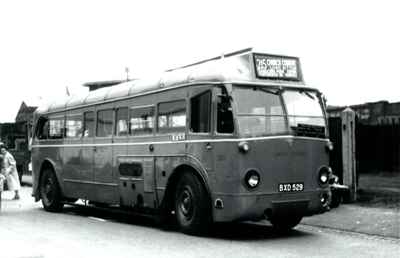
Reason for single-deck operation
As with many of Kingston's south-western routes, the 215
passed under the low bridge on the
Portsmouth Road at Ditton Marsh.
Q8 was numerically the third of the first
production Qs, the 4Q4 class, delivered new to the Country area in
1935. It was one of the batch repainted red in 1948 and sent to
West Green that August for the 233; the
4Q4s proving unsuitable for that route (drivers complained of poor
nearside vision with the doors roped open under police
regulations), they were swapped with 5Q5s from Dalston in
November and worked on the 208.
They were no more successful here, and returned (still red) to the
Country Area in March 1949. Q8 started service at Kingston on 4 Mar
50 - the doors still need to be roped open, but the need was now so
acute that there was no choice. Q8 sits in Kingston ready for a short-working
on the 215 to Church Cobham. The notice fitted untidily under
the nearside window bears minimum fare information applying to
routes 215, 218 and 219 - between Kingston Bus Station and
The Dittons Winters Bridge, and between Surbiton Road and
Giggs Hill Claygate Lane, minimum fare 2 ½d.
This was applied to direct short-hop traffic onto the
higher-capacity trolleybuses, although these terminated at Winters
Bridge. Photo © Alan Cross
Route history
The origins of the Kingston to Esher routes go back
to the very early single-deck operations around London, operated by
independents before the first world war. London Central
Omnibus Co started a new (unnumbered) route in November 1911,
worked by Leyland single-deckers from their Kingston Ceres Road
garage, between Kingston Market Place and Thames
Ditton Fountain. Three weeks later the route
was diverted and extended to run to Esher The Bear,
along what was then the main London to Portsmouth road. This
passed under the low bridge at Ditton Marsh - just on the
Kingston side of the (later) Scilly Isles, where the road goes
under the main line to Woking, Southampton and Portsmouth.
This is still the same today and was the main cause of so many
Kingston area routes being single-deck.
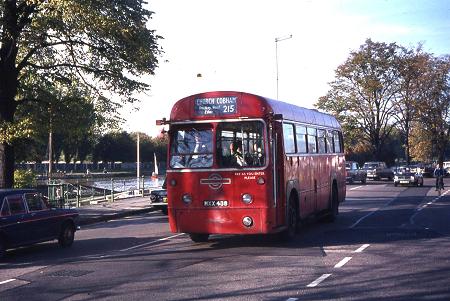
On 1 Jan 13, the New Central (as it had become) buses were
leased to the General, who numbered the route as 79. In
August 1920, the route was extended at weekends to Church Cobham,
with Wednesday journeys added for a few weeks, then Thursday
journeys in late 1920, becoming daily journeys from May 1921.
June 1921 saw a further extension to West Byfleet Station via
Byfleet.
RF461 leaves Kingston
alongside the Thames on 16 October 1976, a week before the route
converted to BL. Note Hinchley Wood on the blind display -
the 215 was rerouted in 1974/75, meaning the blind panel was
produced late enough to have the route number on the nearside, a
feature introduced in 1973. Photo ©
John Parkin
Meanwhile, new route 115 was introduced in July 1921, all the
way from Kingston Market Place to Guildford Horse
& Groom via Cobham and Ripley. This was operated by
Putney garage and used the 26-seat type-7 Bs that had proved too
heavy for the 111. In January
1922, the 79 was rerouted at Esher (see 219 for more details), leaving Cobham served
by the 115, now operated by and from the new Kingston garage.
The route also saw the prototype 32-seat S-class single-decker in
1922 and this class replaced the Bs in 1924. In that year,
the 115 ran hourly.
The route ran through Church Cobham in the one direction only,
otherwise keeping to the old A3 (originally serving Church Cobham
northbound, this being reversed in 1932). 'Church Cobham' is
the main shopping area in the village (where Waitrose is now),
leading down to the River Mole, whilst 'Street Cobham' is the
separate section to the west on the old A3, en route to where
Sainsbury's is now. So far as we can tell, it was only LT
that maintained this historical distinction.
The Kingston Bypass opened in 1927, and in March 1929 the
115 became Mon to Fri only, replaced at weekends by
double-deck NSs on route 620. Because of the low bridge, the
620 travelled via Hook and the Kingston Bypass. The Saturday
and summer Sunday services were twice the frequency of weekdays,
obviously to cater for leisure traffic; in 1930, new STs replaced
the NSs. Meanwhile the single-deck Ks, and the Ss that
latterly worked alongside them, were replaced by new 1T1-class AEC
Regals in 1930. 17 Jul 30 also saw the commencement of the
first Green Line service from Guildford
to London via Cobham and the Kingston Bypass.
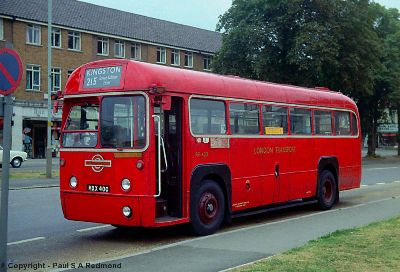 RF423 stands at the stop in Cobham
village. Note the via-point 'Street Cobham' shown on the
blind, which applied northbound only. The non-underlined
fleet name transfer was theoretically meant for Routemasters
but occasionally applied to RFs and RTs on repaint. RF423 stands at the stop in Cobham
village. Note the via-point 'Street Cobham' shown on the
blind, which applied northbound only. The non-underlined
fleet name transfer was theoretically meant for Routemasters
but occasionally applied to RFs and RTs on repaint.
Photo © Paul Redmond
In the 1934 renumbering, the 115
became the 215 and the 620 became the 20. The 1936
timetable shows a requirement for three buses on the 215, with
Guildford Horse & Groom to Burpham shorts fitted
in before each bus returned to Kingston.
Kingston's official allocation replaced the Ts with LTLs in
March 1938. Ts were reintroduced on 6 Dec 1939, under the
changes brought about by the outbreak of war, which led to the
withdrawal of the 20 and the 215 becoming a daily service,
shortened to run from Kingston to Ripley only. The Guildford
to Ripley section had been covered by Country Area route 415 since
1938. The elegant consistency of numbering was continued in
1946, when the Green Line route from Guildford to London was one of
the first reintroduced and was given the number 715.
Wartime brought further changes, including the reintroduction of
higher-capacity LTLs in March 1940, assisted at various
times by Ts from the 218 or
219. From May 1943 to July 1945,
the Sunday morning service was withdrawn between Ripley and Esher,
a move that was to have resonance thirty years later.
After
the war, new 14T13s progressively replaced the Scooters from
March to October 1946, by which time the frequency had
increased to half-hourly to Ripley, plus Church Cobham short
workings. The Ripley to Kingston journeys continued to
avoid Church Cobham. Kingston has operated a number of
classes of single-decker over the years, and there were
regular nominal reallocations between routes, with Qs
replacing the Ts during 1950 and Ts rejoining the Qs from May
1951. Kingston borrowed Qs from Sidcup on Saturdays to
cover a shortfall on that day; its own buses included ex-Country
4Q4s as well as the 5Q5s. It is reported that TDs were used
on the 215 after Kingston received its first in spring 1949, but
the official conversion to TD was 6 May 1953. During the
1940s and 1950s, there was a substantial (but shifting)
inter-working of the 215 with the 218, 219 as well as (from
its introduction in 1954) the 215A.
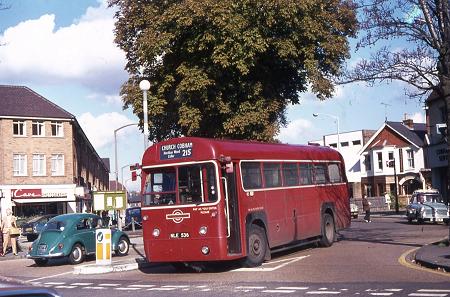 Kingston's Scooters were gone by 1949. The
pre-war Ts lasted until 1953 due to a weak bridge on the 218, and
the Qs also went that year, all swept away by the effect of the
deliveries of red RFs. But Kingston wasn't to see RFs for
another six years, its Ts and TDs ruling the roost until RFs
arrived for the 216 in July 1959. Kingston's Scooters were gone by 1949. The
pre-war Ts lasted until 1953 due to a weak bridge on the 218, and
the Qs also went that year, all swept away by the effect of the
deliveries of red RFs. But Kingston wasn't to see RFs for
another six years, its Ts and TDs ruling the roost until RFs
arrived for the 216 in July 1959.
RF536 at the same
location in Church Cobham a week before the end, on 16 Oct
1976.
Photo © John
Parkin
Six months later, in January 1960, Muswell Hill converted the
212 to RT, releasing over 20
RFs. Many were transferred to Kingston overnight
and used to convert the 218 and 219 joint allocation to RF.
At this stage, the TD-operated 215A to Downside was not
approved for the larger RF; as this weekday route was
jointly worked with the 215, the 215 also kept its TDs on
weekdays. However, at that time there was joint Sunday
working of 215, 218 and 219, so the 215 gained RFs on that day
only.
By October 1961, 215 duties that did not include the
215A were converted to RF, followed by the
215A and the rest of the 215 on 1 Mar 62.
This represented the end of TD operation south of the river - they
continued for another eight months at Edgware on the 240A.
Just over 4 years later, OMO-conversion and transfer to
Norbiton of the 215 and 215A occurred on 23
Jan 66, before conversion of Kingston's 218/219 (bringing to
an end the joint Sunday working), but after the 216.
The first major change to the route for many years came
on 30 Dec 67, following the withdrawal of the 215A
the previous day. The route was cut back from Ripley to
Church Cobham daily, and journeys extended to Downside Mon-Sat, to
cover the 215A. This left the Cobham to Ripley
section unserved except by Green Line 715.
In the major floods of September 1968, which inter alia
flooded Leatherhead garage, the bridge between Cobham to Downside
was partly swept away on 17 September. From that date,
journeys were suspended, with buses waiting time in Cobham.
The bridge received a temporary repair, prior to the building of
the present bridge in 1971, but this proved not strong enough to
support RFs and the route was formally withdrawn beyond Cobham (and
rescheduled) on 18 Jul 69. The Downside service was replaced
by a shuttle minibus provided by Esher UDC on Mon-Fri and MC Ash
(later to become Mole Valley Transport) on Saturdays from 19 Oct
68.
The driver of Norbiton's
RF489 seems to be filling in his duty card, apparently before
reaching the garage as the bus sits in Wood Street in front of
Fulwell's RM1152 on the 281, some time between 1973 and 1976. Both
buses are now preserved.
Photo Peter Gomm
collection
On 8 Feb 75, the 215 was diverted to run via Hinchley
Wood. Originally this was because of road works, but the
section proved a success, so was retained. In this period,
when Surrey County Council were changing their support
arrangements, there were many schedule revisions. Fares were
different outside the GLC area, so ticket machines were specially
adapted for routes 215, 218 and 219.
BLs replaced RFs from Saturday 24 Oct 76, except for
Saturdays when 2 RFs were still required for that day and
a further fortnight, leading to a last day of RF operation of
6 Nov 76.
From 2 Apr 77, Surrey's financial support was withdrawn and
switched to London Country, leading to the withdrawal of the 215
between Esher and Cobham and an increased frequency on Green Line
715 between Guildford and Kingston. Then-local resident Steve
Allnutt tells us that this was highly unpopular - a public meeting
was held at Cobham Village Hall when plans were announced to
withdraw the 215 service. The angry audience were told that the
Green Line 715 route would now serve the village and be re-routed
in to Kingston (having previously used Kingston Bypass; the low
bridge at Ditton Marsh meaning the RMCs would not return). A
march from Cobham was organised about 20 people, along the route
for the 7 miles to County offices! Following the
establishment of the new service, temporary bus stops were added
along the route, but it was soon recognised that residents of the
council estate Northfield Road/Wyndham Avenue could not alight
before a 'round robin' tour of the village and were eventually let
off at the Street Cobham White Lion bus stop toward
Guildford. Steve tells us he 'hijacked' a bus stop from
Fairmile Corner on the A3 and placed it opposite Old Common Road on
several nights - the new stop was eventually established!
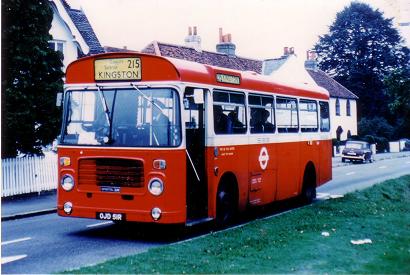
BL51 displays the black on
yellow blind that was intended to alert passengers that the bus was
taking a roundabout route to Kingston.
Photo Ian Armstrong collection
Having seen reasonable stability as a route under RF operation,
change now came thick and fast. The following year, on 28 Oct
78, the route was completely revised to operate from Kingston via
Surbiton and Claygate to Esher and Hampton Court, replacing the
206 and part of the 201, and the allocation moved back to
Kingston.
Kingston's BLs were replaced by Norbiton LSs in 1982, by
which time the route had been cut back from Hampton Court to Lower
Green, with a school journey to Giggs Hill and back to
Kingston. These confusing workings used black on yellow
blinds to warn the travelling public. The route was finally
withdrawn on 26 Jun 87, replaced by midibus
route K3.
Just to complete the picture of the other related routes, the
715 was replaced by the 415 in the 1990s, working for a period
through to Victoria, which was in turn replaced by the 515
operating between Kingston and Guildford. This disappeared in
2016 when Abellio abandoned most of their Surrey operation and was
replaced by new Stagecoach route
715. How tidy.
RF route in detail, with timing points
KINGSTON Bus Station (inbound terminus KINGSTON STATION
from 1966), Clarence Street, Eden Street, High Street Kingston,
Portsmouth Road, Brighton Road
Portsmouth Road, Portsmouth Road, Esher Marquis of Granby,
Portsmouth Road, High Street Esher, Esher High St, Portsmouth Road,
Fairmile Lane Portsmouth
Road, Portsmouth Road Cobham, Anyards Road,
Church Cobham Post
Office, Between Streets (return direct by Portsmouth
Road), Street Cobham White
Lion, Portsmouth Road Wisley, Wisley Hut Hotel, Portsmouth Road
Wisley, Ripley High Street, RIPLEY Post Office (6 Jan 60
to 29 Dec 67).
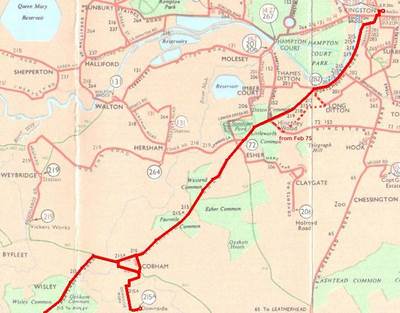
The 1964 bus map (© London Transport)
shows the route running off the edge at
Wisley, plus the section to Downside taken over
from the 215A in 1967.
KINGSTON Bus Station (inbound terminus KINGSTON
STATION), Clarence Street (return via Wood Street), Eden Street,
High Street Kingston, Portsmouth Road, Dittons Winters Bridge,
Portsmouth Road, Esher Marquis of
Granby, Portsmouth Road, High Street Esher,
Esher High Street,
Portsmouth Road, Fairmile Lane
Portsmouth Road, Portsmouth Road Cobham, Anyards
Road, Church Cobham Post
Office (return by Between Streets, Street Cobham), High
Street Cobham, Church Street, Bridge Road, Downside Road, Downside
Common Road, DOWNSIDE COMMON (30 Dec 67 to 17 Jul 69, but see
notes).
KINGSTON Bus Station (inbound terminus KINGSTON
STATION), Clarence Street, (return via Wood Street), Eden Street,
High Street Kingston, Portsmouth Road, Dittons Winters Bridge,
Portsmouth Road, Esher Marquis of
Granby, Portsmouth Road, High Street Esher,
Esher High Street,
Portsmouth Road, Fairmile Lane
Portsmouth Road, Portsmouth Road Cobham, Anyards
Road, CHURCH COBHAM Post Office (return by Between
Streets, Street Cobham) (17 Jul 69 to 7 Feb 75).
KINGSTON Bus Station (inbound terminus KINGSTON
STATION), Clarence Street, (return via Wood Street), Eden Street,
High Street Kingston, Portsmouth Road, Dittons Winters Bridge, Thorkhill
Road, Ewell Road, Sugden Road, Manor Road North, Hinchley Wood Station, Kingston
By-pass, Esher Marquis of
Granby, Portsmouth Road, High Street Esher,
Esher High Street,
Portsmouth Road, Fairmile Lane
Portsmouth Road, Portsmouth Road Cobham, Anyards
Road, CHURCH COBHAM Post Office, (return by Between
Streets, Street Cobham) (8 Feb 75 to 6 Nov 76).
Terminal workings
Ripley: at Post Office, left into Rose Lane (south part, now
closed), layover on stand behind Post Office, return via Rose Lane
(north part) to Ripley High Street.
Downside: as for 215A
Church Cobham: in Between Streets, approximately at the current
layby. At that time, Downside Bridge Road had not been built
north of Church Street.
Norbiton garage journeys: As shown in the above picture, garage
journeys to Norbiton were supposed to show 'Norbiton Church'.
Norbiton driver Stan Attewell (see 'Memories' below) tells us that
at the commencement of service, bus ran out of service to start
work at Kingston Bus Station. Inbound to Norbiton on
meal relief journeys and at the end of the day, there were a
few regular passengers that used the Norbiton Church
service, but in practice many drivers displayed
'Kingston' and then took a short cut down Gordon
Road.
Frequency
| Year |
Mon-Fri |
Sat |
Sun |
| 1936 |
60 mins § |
- |
- |
| 1941 |
30 mins |
30 mins * |
30 mins |
| 1946 |
30 mins * |
30 mins * |
30 mins * |
| 1951 |
30 mins * |
30 mins * |
30 mins * |
| 1953 |
30 mins * |
30 mins * |
15-30 mins * |
| 1959 |
60 mins * |
60 mins * |
30 mins * |
| 1964 |
60 mins * |
60 mins * |
60 mins |
| 1969 |
30 mins *† |
20 mins † |
60-120 mins |
| 1971 |
16-20 mins |
20 mins † |
~90 mins |
| 1976 |
21-30 mins |
21-30 mins † |
~90 mins |
§ Guildford-Burpham 30 mins
* more frequent Kingston-Cobham
† more frequent Kingston-Esher
From Kingston, the route took about 35 minutes to Church Cobham
and about 50 minutes to Ripley. The July 1967 timetable is
here.
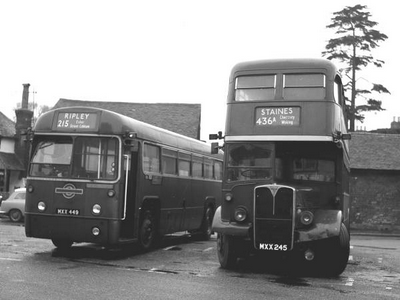 RF allocation RF allocation
Allocation joint with 215A Mon-Sat to 1967
PVR 1960: Mon-Fri 9 TD, Sat 9 TD, Sun 15 RF jointly with 218 and
219 (18 in summer)
PVR 1961: Mon-Fri 6 TD, Sat 7 TD, Sun 8 RF
jointly with 218 and 219
PVR 1962: Mon-Fri 6, Sat 7, Sun 8 jointly with 218 and 219 (10
in summer)
PVR 1966 (OMO, NB): Mon-Fri 7, Sat 8, Sun 2
PVR 1967 (Dec): Mon-Fri 6, Sat 7, Sun 2
PVR 1969: Mon-Fri 5, Sat 6, Sun 2
PVR 1971: Mon-Fri 5, Sat 6, Sun 1
PVR 1972: Mon-Fri 4, Sat 6, Sun 1
PVR 24-31 Oct 76: Mon-Fri 4 BL, Sat 2 RF + 4 BL, Sun 1
BL
Now here's a treat - a
picture of RF472 on the stand behind Ripley Post Office,
alongside RLH45 on the 436A, which has arrived from the
other direction. Occasionally, RLHs arrived as a 415 and
departed as 436A and vice versa (these were
positioning journeys for the 436A from
Guildford). There are now more cars (but not A40s) and no
buses in Rose Lane.
Photo © Mike Beamish
Memories
Hell's Grannies - Ian
Hogben tells the story of one of his passengers
here.
Stan Attewell was employed
at Norbiton from June 1964 to 1990 and started driving crewed
RFs on 201 & 264. He shares a few of his memories:
'I started work at NB in June 1964 and trained at Chiswick
on the RTW, then type-trained on a Private Hire RF and the RM.
I initially worked with a conductor on the 201 and 264
(without doors of course). In November 1964, the 201 went OMO
and I transferred to that for another £5 a week. In
1966, we got the 215/A and then in 1969 RFs started
working the 285 on Sundays. I stayed on RFs until the BLs
arrived.
One evening on late duty I pulled into Kingston after completing
a journey from Downside, when a police officer and bus inspector
came over to me to ask a favour. A Southdown coach was parked there
whose driver had been injured when someone had thrown something at
the screen. They asked if I would take the passengers to
Victoria, where all-night coaches had been told to wait for my
arrival. We loaded 45 people onto the RF plus loads of
suitcases down the gangway and off I went. When I got there,
the poor RF was steaming but the passengers all got their
connections.
Another time, I was the last bus to Downside. It snowed in
the early hours of the morning and had settled when I got to
Downside. To turn at the common, you had to reverse into a
side road. As I did so, the bus lost all its air pressure
- it transpired it was because snow had got under the bus and
the belts were slipping. The engineers came out to remove the
snow from the underneath with hessian flares, but in doing so
they set the floor alight. I was in someone's house having a
cup of tea at the time.'
Re-creation
RFs again operated the 215 to Ripley at our Kingston 2009 RF event.
|
|